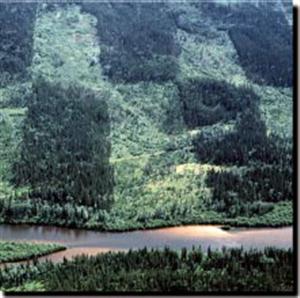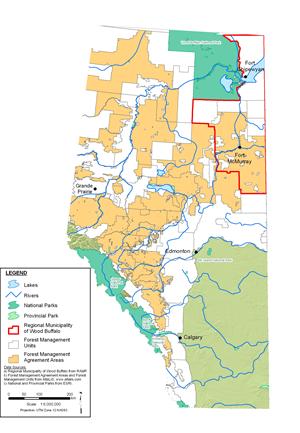Forestry Development in the Oil Sands
As the landscape of northern Alberta is quite wet (muskeg-, wetlands), logging must be carried out when the ground is frozen and can support heavy equipment. This limits most logging in northern Alberta to the winter (Northland 2008).
Logging companies begin by determining where in the forest to situate roads and cutblocks (areas to be clearcut), and flagging these areas for clearing and construction. Roads must be constructed properly for harsh winter conditions, and must withstand the weight of heavy harvesting and transportation equipment.
One such harvesting tool is the feller-buncher, which grips the tree in a mechanical arm, cuts it off at the base with a circular saw, then places it on a stack to be transported (skidded) from the harvest site to the roadside, where it is de-limbed and possibly cut into shorter logs (bucked) (USDL 2008). Trees may also be felled by loggers using chainsaws, and de-limbed where they fall before being moved to the roadside. There, the trees are stacked onto logging trucks, and sent to a mill for further processing. Under Alberta law, reforestation efforts must be started within two years of harvest (ASRD 2002).
Nearly all (96%) forested land in Alberta is publicly owned. Responsibility for forests on this publicly owned land lies with the provincial government, which has established rules and regulations for forest management. To legally harvest from a section of forested land, a forestry company must hold one of the following (ASRD 2008b, ASRD 2007, ASRD 2001):
Forest Management Agreement (FMA), a long-term agreement between the province and a forestry company that gives the company the rights to manage, grow, and harvest timber on a specific area of land. FMAs generally cover a period of twenty years, and are only renewed if the company has a good record of environmental compliance and performance. Forest Management Plans, which provide specific harvesting and land management details, are required under a FMA and must include public consultation.
Timber quotas are twenty year agreements between the province and a forestry company that give a company the right to harvest a share of the annual allowable cut (the amount of wood that can be harvested each year, based on the amount of wood replaced by the forest each year) from a particular forest management unit. These agreements are renewable based on past environmental performance. Under timber quota agreements, the province is responsible for long-term forest management planning, although the quota holder also actively participates. More detailed operational plans, plan implementation, and reforestation are the responsibilities of the quota holder.
Timber permits are short-term agreements used to meet specific, local demand for timber (e.g., for Christmas trees or firewood). These agreements can extend from thirty days to two years depending on the purpose of the agreement.










